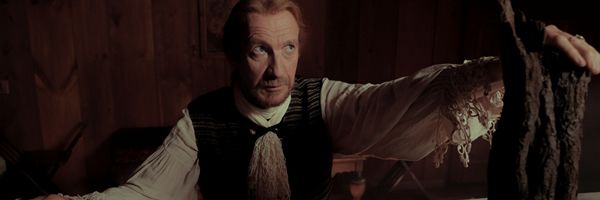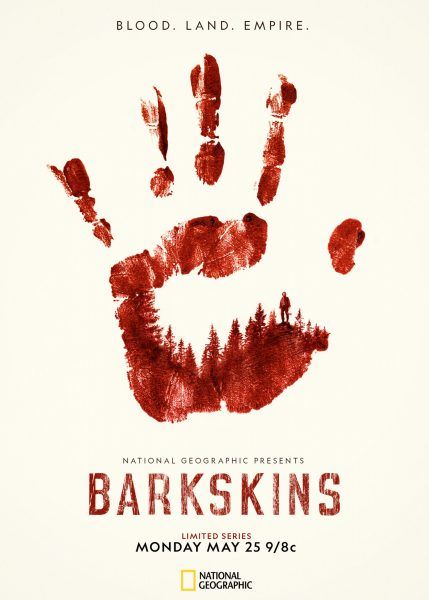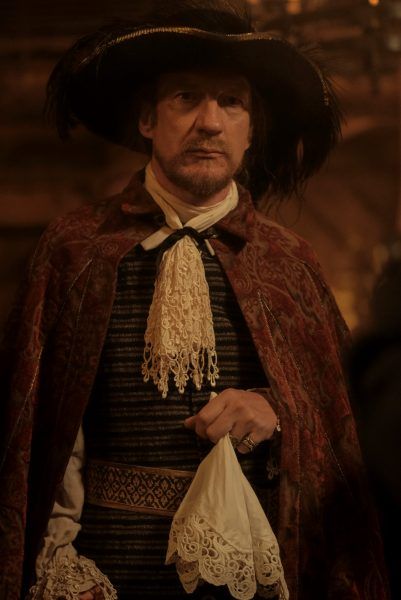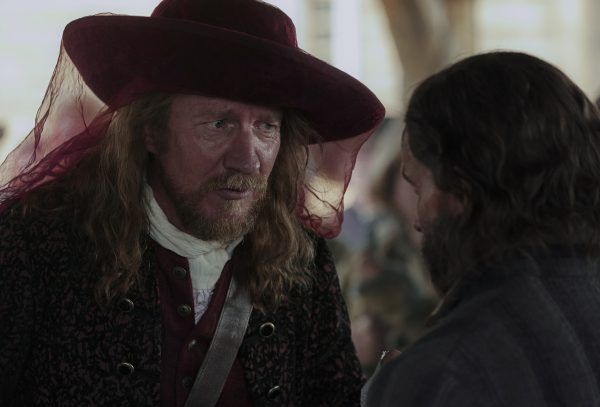From creator Elwood Reid and based on the best-selling novel of the same name by Annie Proulx, the National Geographic eight-part limited series Barkskins transports viewers to the wild frontier of the late 17th century, as the mysterious massacre of settlers in New France threatens to tear everything apart. This treacherous new frontier forces the collision between civilization and commerce, while the dream of carving out their own place on the new American continent turns into a fight for survival. The series stars David Thewlis, Marcia Gay Harden, Aneurin Barnard, James Bloor, Christian Cooke, David Wilmot, Thomas M. Wright, Tallulah Haddon, Kaniehtiio Horn, Lily Sullivan and Zahn McClarnon.
During this 1-on-1 phone interview with Collider, British actor David Thewlis talked about why Barkskins was such a stand-out project for him, why he’d rather wait for great writing to come along before signing on to play a particular role, his approach to finding this character, filming in the real location that this story took place, and whether he’d like to continue to explore this character in another season. He also talked about his rather unusual experience on Avatar (he’s set to be in parts 3, 4 and 5), and what it’s like to work with director James Cameron.
Collider: I’m so fascinated by this story and your character, Monsieur Claude Trepagny, and I’ve just never seen anything quite like this series before. Was that part of the appeal of this project, for you?
DAVID THEWLIS: I’d never come across anything like this before, either. I felt that the story and the history was fascinating, being British and being involved in many, many historical period dramas. I knew nothing about this period of history. I’m very familiar with this century, and I knew about English and European history, and I was aware of the Québécois in Canada, but I never really studied how that all came to be the case. That was really why I wanted to do this part. I just found it fascinating, historically, and wanted to tell a story that I hope a lot of other people learn from, as well. We’re so used to North American history and this period being centered around the first settlers in Virginia, but I knew nothing about this and it fascinated me. And then, to see all of the production design and costumes, and everything, and how the story evolved, was so interesting.
I was also such a fan of the work that you did on Fargo. Much like you’ve said previously, when I heard that Fargo was being made into a TV series, I thought it was a terrible idea, but then I watched it and was proven wrong. It’s just a really terrific show. What did you most enjoy about playing in that world and exploring that character, especially having come to it, as a fan of the show?
THEWLIS: The great thing is that you think it’s a terrible idea until you see the first season and it’s fantastic. By the time I was offered the third [season], I’d watched the second season and I knew it was just really wonderful TV and that I was in very good hands. I’d met (show creator) Noah Hawley by then, and I knew that I was in safe hands, even from the first script that came in. I had to trust them because my character, Varga, wasn’t that prominent in the early scripts, but I was told that he was gonna become very, very prominent. In fact, I was told that he would survive. I was told the very end of the story and that, if you wanted to interpret it that way, he would be victorious. It was just a real joy to do that.
Does it change how you look at projects, when you play characters like the one in Fargo and the one in Barkskins? Does that level of quality raise the bar even higher for you?
THEWLIS: Yes. It always feels like that, but there are so many wonderful writers out there, that something always tends to come along. I’m saying this ‘cause I actually just read something like that. With the way the world is right now, I’m not quite sure what I’m doing next. I know that I have something that was supposed to shoot in June, that isn’t shooting in June, but may shoot in September, or could go into next year. Then, I read something just a few hours ago that may shoot very soon because of the nature of it, and it’s something that’s superb, but set in a completely different world. After Fargo, I thought, “How can I find a part that’s as beautifully rich as this?” And then, something comes along like Barkskins, which is a completely and utterly different world, story and character. Looking into the future, I’ve got two things, and they’re both very, very different, but they’re both wonderful because of fantastic writing. That seems to have gotten better. As my career has gone on, I seem to work with better writers, or I’m just getting better at choosing. I can hang out and take time off work, until the writing comes along. Right now, I don’t have to work, work, work. I can take it easy for awhile, until some great writing comes along.
Was the character in Barkskins somebody that you immediately got a feel for, on the page? Did you immediately see what it was that you could and wanted to bring to him?
THEWLIS: No, not immediately. I prepared a lot of it at home, here in England, because there was an awful lot of dialogue. He had long speeches, and I wanted to get started on that, as early as possible, because I also had the accent to do. So, I started learning those quite a long time ahead of time, which I do. I learn things, very, very far in advance. By the time I turn up on set, I like to know everything. That’s difficult with TV ‘cause you get new scripts, all the time. I roam around. In England, where I live, there’s some forest land nearby, not dissimilar to the land where we were shooting, just not as big. I strolled that area, with some big boots, a hat and a walking cane, shouting amongst the trees in a French accent for any of my neighbors. I’m quite new to this neighborhood, so I’m sorry for any of my neighbors that heard me shouting in the woods. But I feel like I discovered him, back at home in England, before I really arrived on the set.
What was it like to work on these sets and have the room to move around what essentially seems to have been a village built in the woods? What do you think would most surprise people about the sets?
THEWLIS: The nice thing was to be filming in the real location, where this took place. This is not a true story, but the situation and circumstances are true, and the setting. So, we were in the real place, and not somewhere sort of like it, but in Quebec, up in the mountains, in the woods, every day. My character was mostly in exteriors, but even when we were inside, we were inside those houses that you see. We weren’t on a stage set. There was no studio. Any of those buildings that you see the exteriors for, we were inside those buildings. That makes it all the more real, and it was really just very beautiful. I really adored it. I’m not a person who’s really been in much nature. I’ve always lived in the city, and only recently have I moved out to the country in England and really embraced nature a lot more. This made me fall in love with it. I was seeing many things for the first time, and I really made sure to I appreciate it, every single day, when I drove up the mountain and got out of my car. I never took it for granted because it was really exceptionally fortunate to be working in such circumstances. The weather was mostly beautiful and it felt healthier, being away from all of the pollution. We were striving up the mountain, every day, and breathing good air. It was special.
When you don’t know where a character is going, you really can only work with where he currently is. What were the character dynamics and relationships that you most enjoyed, and what would you still like to get to explore?
THEWLIS: There was some stuff we did that I don’t think there was room for in the edit. There were some esoteric flights of fantasy with that character, that didn’t drive the story, so when things were running over, in terms of time, we’d have to cut some things, or cut them before we shot them. Elwood would often go, “I just wanna give him more bullshit to say ‘cause he’s such a good bullshitter.” That was the real key to it. He does talk crap, a lot of the time. He’s very good at making it sound like he knows what he’s talking about, but he really enjoys it. He’s a cross between being a bullshitter, and being extraordinarily delusional and fantastical. That’s very entertaining to play with, and I think we could go further that way and maybe make him not make quite as much sense. You could pull him away from the storyline and just allow him to fly a little bit, so he’s not so involved in exposition, but he’s just having some fun.
What did you most respond to, in working with David Slade, who directed the first two episodes and really established the look and feel of the series?
THEWLIS: David, as the first director, is the guy you have to really trust. Working in television, as opposed to film, you don’t feel like you’re really making anyone one single vision. You’re making Elwood Reid’s vision because he’s the showrunner, but he’s not the director and he’s not there, all the time, and there is no director that’s there, all the time. So, you have to accept that the vision and feel of the whole thing is gonna really belong, very much, to that first director. And then, all of the subsequent directors have to really take notes from the style of that first director. So, you really had to invest a lot of trust with David, that he’s getting the tone right. It’s not like the other directors can then veer off and go make their own program. They’re really acting under his umbrella. It requires an enormous amount of trust, which David had because he’s done some fantastic work. Between David and Elwood, it was very important to believe that they knew what they were doing, and that it was what you had signed up to do, in the first place.
When I spoke to your showrunner Elwood Reid about Barkskins, he told me that he has this file full of ideas for Season 2 and that he certainly has more than he wants to write for these characters. Is this a character that you hope to return to? Is he someone that you’d like to continue to explore?
THEWLIS: Yeah, absolutely He was just such fun. I really had a good time making it. I had a great time with all of the other actors. It was a very good-humored set. I really respect our work. One can get bored playing some characters, and sometimes you wouldn’t want to do it again. With film, you rarely do . Sometimes I’m glad that I’ve put that character away and to bed, but with this character, there are lots of places he could go because he is such an enigma and such an anomaly. It’s almost like anything could be possible with him. I feel he’s a little under-explored anyway. Because the book is so enormous and we were limited to eight episodes for time, Elwood certainly feels that he’s only told a small part of the story that he wants to tell, so far. I’d be happy to get back into those woods.
You’re also working on the Avatar sequels. What’s it like to work and collaborate with James Cameron, who’s someone with a very definite approach and vision, as a director?
THEWLIS: Well, nothing could be more different than Avatar. It completely doesn’t resemble anything that I’ve ever done. I should be clear, by the way, ‘cause I know that a magazine in Britain has got me in Avatar 2, but I’m not in Avatar 2. I’m going to be in Avatar 3, which was shot at the same time as Avatar 2, and the plan is that I will be in Avatar 4 and 5, as well. I just wanted to clear that up because somebody got that wrong recently. I loved working with Jim Cameron. I was a bit nervous ‘cause I’d heard stories that he’s quite a hard task master. I’d heard stories about the filming of Titanic, and that he could be quite difficult. He wasn’t difficult, at all. He was nothing but an absolute pleasure, and I had a great laugh with him. He’s something of a genius. He does everything. He’s an engineer, an artist, a filmmaker, and a writer. He’s just an extraordinary character. I felt very naive. I didn’t really know what I was doing because I’d never shot in that way before. It’s not really like making a film, at all. It doesn’t resemble it, in any way. Everything was completely new to me. I didn’t know what the hell I was doing. There were lots of younger actors on set, who had to tell me what to do next because I felt like an old man. It was a great challenge, and I look forward to doing more of it. Jim Cameron was delightful. I admire him greatly.
It must be a very different experience, when you go from doing something like Barkskins, where you have everything there and can touch everything, and then you do something like Avatar, where you’re in a motion capture suit and you have funny dots all over you.
THEWLIS: Yeah. It’s the complete opposite. People told me, “Oh, you’re going to love it. It’s like doing theater.” It’s not like doing theater. It’s not like doing film, either. Motion capture is bizarre. You’re in a velcro suit all day, with a camera right in your face, all day, every day. If you sit down for too long, you have to be re-calibrated. And if you touch anyone else, you get stuck to them ‘cause you’re all made of velcro. It’s fairly uncomfortable. You don’t know what’s going on or where you are, and it’s baffling. But therefore, it’s novel and super interesting because you’re never bored. It’s quite a thing.
Barkskins airs on Monday nights on National Geographic.




